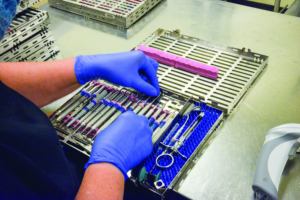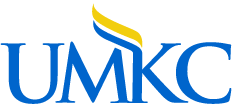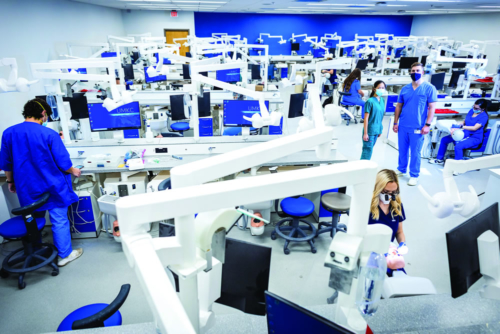By Stacy Downs
The UMKC School of Dentistry and the dental profession are thinking and moving forward. The COVID-19 pandemic made tomorrow’s plans happen right now.
The forecast for the UMKC School of Dentistry and the profession itself: bright, and something to smile about. To get a glimpse into the future, we caught up with current profession leaders. By the way, we couldn’t help but notice how many prominent
national organizations are led by UMKC School of Dentistry alumni. We also learned that even during the challenges and uncertainties of the COVID-19 pandemic, those training future oral health professionals are demonstrating how to adapt, evolve and thrive. Going above and beyond
During the COVID-19 pandemic, the UMKC School of Dentistry is taking extra precautions to keep everyone safe. More than 300 students, faculty and staff treat 65,000 patients in a typical year in its clinics. For starters, there are dozens of external oral suction systems (EOS)
that quickly remove 98% of fluid filled particles. A bipolar ionization filtration system, which kills viruses, has been added to the heating and air-conditioning system in the clinic.
Scheduling has changed to shorten wait times and reduce patient loads in the waiting area, where easily disinfected
and well-spaced plastic chairs have replaced densely packed cloth-covered ones. Patients are contacted the night before an appointment to make sure they are well, and they are screened again on arrival, including a temperature check.
Patients use one entrance; faculty, staff and students use another, with their swipe cards recorded to aid contact tracing should it be found later that someone in the building tested positive for the coronavirus.
The school has been helped in reopening by safety guidelines from the Centers for Disease Control and
Prev ntion, the Occupational Safety and Health Administration, the American Dental Association and the Academy of General Dentistry.
“COVID-19 has changed everything,” says Russell Melchert, interim dean of the UMKC School of Dentistry. “I’m proud of the faculty, students and staff who continue to teach and learn about the next generation of oral health care, by above and beyond with new and better ways.”
The change was dramatic, says Kaz, associate dean for academic affairs and clinic associate professor (BSDH ’86, MSDH ’87). It meant transitioning four years of didactic courses in dentistry and dental online. It meant certifying instructors in online teaching for creditation purposes.
“We had to move fast and learn online ways of instruction on the fly,” Kaz says. “Those who want to be in this profession tend to be ‘people persons’ so this was all challenging.
 Patient safety remains paramount at UMKC.
Patient safety remains paramount at UMKC.
In the Fall Semester, many courses are online but there is in-person instruction in clinics and for
first-year students to help foster community and connection.
While much of the curriculum at the school already focuses on future dental trends such as group practice (versus solo practitioner) and new technologies, the pandemic pushed a foray this semester into teledentistry. This works by having patients see their general dentist, but receive guidance from a specialist elsewhere during that visit. It means convenience and less travel for patients, especially those in rural areas.
“This technology has taken off for medicine, and it has really moved us down that field,” Kaz says. “This semester, we’re piloting a program
that sends information from clinic to clinic. It’s showing what a teledentistry environment would mean in their practice.”
Next generation Each year, U.S. News and World Report ranks top jobs based on categories including future demand and growth, work/life balance, and salary and stress levels. Consistently, dentists rank in the Top 5 (No. 2 in 2020), and orthodontists and dental hygienists rank high as well.
Will the pandemic affect this detrimentally? Leaders don’t think so. “Dentistry was deemed an essential medical service,” says Craig Herre
(DDS ’81), who serves as first vice president of the American Dental Association and has a practice in Leawood, Kansas. “People were so
happy about that because dentists are well-respected and are important to people’s health.”
Herre sees more dentists specializing in pediatric dentistry and focusing on health issues including sleep disorders and TMJ (temporomandibular joint dysfunction), and the opportunity for other niches including geriatric dentistry and serving those with
developmental disabilities. “There’s something for everyone,” he says.
According to Herre, the profession is always changing because of generational shifts and preferences. All his life, he’s had a front-row seat to this evolution. His father, Bill Herre (DDS ’53), was a dentist and the founder of their family’s practice, and now his son, Tim Herre (DDS ’08) is a dentist in the practice.
 Online or in person, dental education carries on.
Online or in person, dental education carries on.
Most of today’s dentists are Generation X with large numbers of millennials and Generation Z becoming dentists, Craig Herre says. Everything from how appointments are made to patient billing to service expectations is much different from what’s typical of baby boomers, who are retiring. So much of this is due to technology. For example, Grant Olson, (DDS ’11) owner of Innovative Dental in Springfield, Missouri, specializes in same-day dentistry.
With dental restorations, it often takes a few weeks for them to be made, as well as a few patient visits with trays of impressions, sending them to a lab to be made and fitted.
Instead, Olson uses CEREC or chairside economical restoration of esthetic ceramic. This is a system that uses CAD and CAM — computer-aided design and computer-aided manufacturing — to fabricate dental restorations including crowns, inlays, fixed bridges, veneers, implants, dentures and orthodontic appliances. Olson’s practice has six mills in the office.
“A patient can be in and out of here within an hour with a new crown, a new smile within the day,” Olson says. “We have a lot of patients come in from out of town so this is convenient for them and the precision of the technology is more accurate and makes for a better restoration.”
Most labs still do it the weeks-long way, he says. But now this type of digital dentistry is part of the education UMKC is delivering through its dental school. “Technologies continue to advance,” says. “And the school is on top of that.”
A new way to secure the future Brett Ferguson wanted to give back to the UMKC School of Dentistry. A graduate in 1981, today Ferguson is chairman of Oral and Maxillofacial Surgery t Truman Medical Centers, a past chair on the Rinehart Foundation Board and past president of the American Association of Oraland Maxillofacial Surgery. And he is a proud School of Dentistry donor. “What I wanted to accomplish give back and make sure somebody gets the opportunity to do something that I’ve done,” he says. “I needed to find a way to give financial support to those entities that I care about.” Estate giving, by way of a life insurance policy, was his answer. After calling his insurance company and explaining what he wanted to do, he learned he could do it through a life insurance policy. “A policy wasn’t that expensive and I could write it off,” Ferguson says. “It’s a great way for alumni donors to give because it doesn’t really hurt but yet they can see what they are
doing. It was very, very easy to do, and to get tax benefits on top of being able to provide for those you want to support, it was a no brainer.”
As the school adapts to meet the changes in both the dental industry and the educational programming needed to prepare future dental professionals, support from its alumni becomes even more important. Ferguson knows this well and encourages others to “find out what
the school is trying to accomplish and in some aspect get involved. Keeping a strong line of attachment with the School of Dentistry is what we are trying to build.” He advises to start small, create a connection and then ultimately move to talking about legacy gifts. “That is a good way to build up your corpus over time,” he says.
‘An awesome opportunity’ As you all know, the UMKC School of Dentistry has a great reputation. Starting when he was a kid in a dental chair in Western Kansas, Interim Dean Melchert grew up knowing about the school because his dentist was an alumnus. So when Melchert started as dean at the UMKC School of Pharmacy 11 years ago, he sought out the clinic for his dental care.
“I recommend it to everybody,” says Melchert, who began his interim position in September following the retirement of Marsha Pyle, who had served as dean since 2009. A national search for the new dean of the UMKC School of Dentistry began in November. “What an awesome opportunity for someone to lead a place that is known locally, regionally, nationally and even internationally for its research,” Melchert says.
Founded in 1881 as the Kansas City Dental College, the UMKC School of Dentistry is the only public dental school in Missouri and Kansas, and most of the oral health professionals in those states are alumni. The school also has a large alumni base across the ocean in Hawaii that
dates back to World War II, when much of the United States was seized with fear of Americans of Japanese descent; the dean at the time took a different path and welcomed Japanese- American students with open arms. In 2016, the school was one of only three dental schools in the country to be recognized with a Health Professions Higher Education Excellence in Diversity Award from INSIGHT Into Diversity magazine, the oldest and largest diversity-focused publication in higher education.
The UMKC School of Dentistry is known around the world for its research, consistently winning significant National Institutes of Health grants and attention from media around the country and the globe for its research in dental biomaterials and bone biology.
Like few others in the country, its learning environment is uniquely positioned as well. The UMKC School of Dentistry is part of the UMKC Health Sciences District, collaborating with the UMKC Schools of Medicine, Nursing and Health Studies, and Pharmacy, as well as Children’s Mercy, Truman Medical Centers and city, county and state health institutions.
“The UMKC School of Dentistry is a huge asset to the Kansas City, delivering clinical care to more than 65,000 patients each year,” says UMKC Provost Jenny Lundgren. “We’re looking for strong candidates who can build on the enormous impact of this more-than-century old
institution and continue to move the dental profession into the future through compassion, education and innovation.”
Lundgren says the search committee also will be looking for a dean who can build on community engagement and fundraising. In 2019, the school opened a new state-of-the art simulation lab funded through donor support, largely from alumni. The next dean of the UMKC School
of Dentistry is expected to be hired in spring with an anticipated start inthe summer of 2021.
“It’s going to attract some of the best candidates in the country,” Melchert says. “That’s exciting!”


